

Vol. 40 (Number 27) Year 2019. Page 16
ZAKHARKIN, Oleksii O. 1; BASANTSOV, Ihor V. 2; MYROSHNYCHENKO, Iuliia O. 3 & SHCHERBACHENKO Viktoriia O. 4
Received: 22/03/2019 • Approved: 03/08/2019 • Published 05/08/2019
ABSTRACT: The aim of the article is to analyse the innovative development directions for industrial enterprises. Innovative development is considered as a driver of national security. Authors make the comparison of innovative development vectors of industrial enterprises in Ukraine and in the world. Analysis of the impact of environmental factors on the innovative activity of enterprises is conducted by authors. The structure-forming and priority sectoral development vector are defined. The instruments of stimulation and state support of innovative activity are suggested. |
RESUMEN: El objetivo del artículo es analizar las direcciones de desarrollo innovadoras para empresas industriales. El desarrollo innovador es considerado como un motor de la seguridad nacional. Los autores hacen la comparación de vectores de desarrollo innovadores de empresas industriales en Ucrania y en el mundo. El análisis del impacto de los factores ambientales en la actividad innovadora de las empresas es realizado por los autores. Se definen los vectores formadores de estructura y prioritarios de desarrollo sectorial. Se sugieren los instrumentos de estimulación y apoyo estatal de la actividad innovadora. |
Since 2015, the provision of the economic security of the state is defined as the key condition for the new quality of economic growth, according to the National Security Strategy of Ukraine (2015). A number of measures are aimed at maintaining the stable functioning of the system of state economic security, in particular, the deoligarchization, demonopolization and deregulation of the economy, the protection of economic competition, simplification and optimization of the tax system, establishment of a favorable business climate and conditions for accelerated innovation development. The Strategy identifies the need to attract foreign investments in key sectors of the economy, including energy and transport sectors, as tools needed to ensure national security. Special attention is paid to the development of the military-industrial complex as a powerful high-tech sector of the economy that is capable of playing a key role in its accelerated innovative modernization. At the same time, two research questions arise in connection with the global spread of a new concept of economic and social development "Industry 4.0" and the transition to the ideas of a circular economy: "What types of industry can stimulate sustainable socio-economic development in Ukraine?" and" What innovative drivers should be used in business processes of industrial enterprises in order to achieve economic security of the country?".
The problem of ensuring the economic security of the state is continually gaining attention in scientific literature. Fig. 1 shows the number of scientific papers devoted to the subject of "economic security" published per year in the world according to Elsevier's Scopus database. The exponentially growing number of publications per year proves that "economic security" is currently a relevant research topic.
Fig. 1
The number of publications with the keyword "economic security"
per year in the world according to Elsevier's Scopus database

Source: compiled by the authors
It is worth noting that, according to the number of scientific papers published in the Scopus database, the problem of economic security is most relevant to the Russian Federation, the United States of America, China, England and Germany (Fig. 2). Ukraine is in the top 20 countries by the relevance of the topic of economic security.
Fig. 2
Relevance of the topic "economic security" by the geographical
criterion (top 20 countries) according to Elsevier's Scopus database
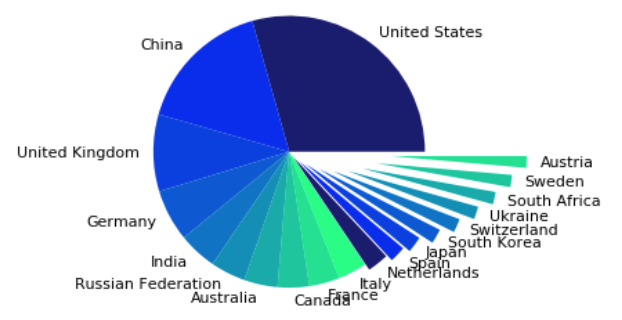
Source: compiled by the authors
Considering global market trends, in order to ensure the economic security of the country, it is necessary to create a fundamentally new institutional environment aimed at increasing the competitiveness of the economy through innovation, technological modernization, development of nanotechnology and improvement of the production structure in accordance with the fourth industrial revolution. The economic security of the country can be achieved with the help of productive enterprises that play an important role in the society, contributing to its development, increasing the number of jobs and improving the quality of life.
Production has traditionally played a key role in the economic growth of developing countries (Kuznets, 1966; Kuznets, 1971; Kaldor, 1967). Kuznets (1966) stated that industrialization, or, in other words, an increase of the production share in GDP, is the main feature of economic growth. Kaldor (1967) characterized the manufacturing sector as "the main engine of rapid growth". Szirmai and Verspagen (2015) analyzed the correlation between the share of the added value of production and the growth of GDP per capita in 92 countries and concluded that manufacturing is an engine of growth for low-income countries, as well as for middle income countries, provided that they have sufficient levels of human capital. Similar results were obtained by Guisan (2008), who found that production had had a positive impact on economic development in Europe, America, Africa and Asia in 1999-2006.
The importance of the production sector for economic growth lies in the positive correlation between the rate of production growth and the rate of productivity growth in other sectors of the economy. Advanced economies such as those in the United States, Australia or EU member states are directing their efforts at reindustrializing their economies after decades of deindustrialization (Helper et al., 2012). According to UNCTAD, during the period from 1980 to 2014, the share of industry in developed countries has decreased from 28.3% to 18.5%, and from 38.3% to 28.2% in those with transition economies. At the same time, the share of the service sector has increased from 61.6% to 75% in developed countries and from 42.1% to 53.1% in transition economies (Kindzersky, 2017). In its strategy "Europe 2020: strategy for smart, sustainable and inclusive growth", the European Union has identified industry as one of the seven main initiatives of the European strategy and has set a course to increase the share of industry to 20% of GDP. At that, the emphasis is on the need to combine industrial development and inclusive growth, that is, to enable the society, through high levels of employment, to invest in knowledge and skills; to modernize labour markets, education and social protection, to help people anticipate and manage changes, and to ensure the unity of the society. The USA has developed a strategy for transitioning to the advanced knowledge-based production through cooperation between the government, industry and academia (The National Science and Technology Council, 2016). New technological fields in the USA include manufacturing of advanced materials, engineering biology for advanced bioindustry, bioproduction for regenerative medicine, improvement of the production of bioproducts and pharmaceuticals. Deindustrialization, which is characteristic of developed countries, lies in the shift of production under the influence of scientific and technological progress to the high-tech sector. It provides an impetus to the accelerated development of knowledge-intensive and logistics services that the growth of productivity, production innovation and efficiency of supply chain management of products to markets relies on. Deindustrialization is primarily accompanied by a decrease in labour intensity and the shift of productive activities to low-income countries, and is based on trade between developed and developing countries (Tregenna, 2009; Kucera and William, 2003; Rowthorn and Ramaswamy, 1997).
Increasing the sectoral share of production in the gross domestic product (GDP) to 25% by 2022, and developing production zones to create 100 million jobs in order to improve global competitiveness and increase the share of value added were identified by developing countries, such as India, as the main objectives of the national production policy in 2011. The Philippines has developed an interdepartmental document "The Philippine Manufacturing Industry Roadmap" (Rafaelita, 2014) which determined that the manufacturing sector should contribute to the economy 30% of the total value added and should provide 15% of the total employment of the population. The industrial policy will focus on horizontal and vertical coordination mechanisms, innovation and technology, and will focus on strengthening supply chains and linking domestic enterprises with multinational companies to achieve inclusive and sustainable growth. It is worth noting that premature deindustrialization in developing countries reduces the potential for economic growth and opportunities for convergence with income levels of developed countries. In this case, production is replaced by services that are not associated with improving production efficiency – trade, rent, repair, etc.
In general, industrial enterprises should be able to develop production systems and supply chains and adapt to the needs of consumers in the markets, focusing their activities strategically. Such conditions will contribute to an increase in the level of modernization of production processes and broadening of technological capabilities in many countries / regions of the world where production activities were not so expressive. For example, questions of strategic planning of innovation activity of enterprises are considered in the work of Zakharkina L.S. (2009). Despite the relevance of the study and the significant contribution of scientists to solving the problems of economic security of the country, a certain range of conceptual issues requires detailed consideration. The first issue is to find out what types of industry are stimulating for sustainable socio-economic development and what innovative drivers must be applied in the business processes of industrial enterprises to achieve economic security of the country.
According to the 2018 European Innovation Scoreboard, Sweden is the EU innovation leader, followed by Denmark, Finland, the Netherlands, the United Kingdom, and Luxembourg, which joins the top innovators group this year. Germany drops to the group of strong innovators (European Commission Press release, 2018).
On average, the innovation performance of the EU has increased by 5.8% since 2010. Over the last 8 years, innovation performance has increased in 18 EU countries and decreased in ten. The performance has increased the most in Lithuania, Malta, the Netherlands and the United Kingdom while it decreased the most in Cyprus and Romania.
At the global level, the EU is catching up with Canada, Japan and the United States. The EU maintains its lead over China, but this lead is decreasing rapidly with China having improved almost three times as fast as the EU. Relative to South Korea, the EU has been falling behind, but a gradual catch-up is expected over the next years.
In selected areas of innovation, the EU leaders are: Denmark – human resources and innovation-friendly environment; Luxembourg – attractive research systems; France – finance and support; Ireland – innovation in SMEs, employment impacts, and sales impacts; Belgium – innovation linkages and collaboration.
According to the 2019 World Economic Forum, there are six drivers of production: technology & innovation, human capital, global trade & investment, institutional framework, sustainable resources, demand environment. Let us briefly consider what such driver as Technology & Innovation assesses. It estimates how advanced, secure and connected is an economy’s ICT infrastructure used for adopting technologies in production; the ability to foster and commercialize innovations that have potential application in production. Thus, Readiness Overall Assessment shows that Ukraine takes the 74th place (out of 100) in rank by technology & innovation, 34th by human capital, 59th by global trade & investment, 94th by institutional framework, 88th by sustainable resources, 58th by demand environment.
In Ukraine, there is a difficult situation in the industrial sector of the country, due to the relatively low quality of products, outdated equipment and technology, and the lack of adequate funding. Cheap raw materials and a rather weak corporate culture in Ukraine lead to insufficient inflow of investments and, correspondingly, to low competitiveness in the domestic and international markets. Ukraine's heavy industry is largely inherited from the Soviet Union with its inherent state property, and has failed to comply with foreign investments. Fig. 3 reflects the dynamics of value added (% of GDP) of the industrial sector, service sector and agriculture in Ukraine (built on the basis of World Bank national accounts data, and OECD National Accounts data files).
Fig. 3
Industry, services and agriculture,
value added (% of GDP)
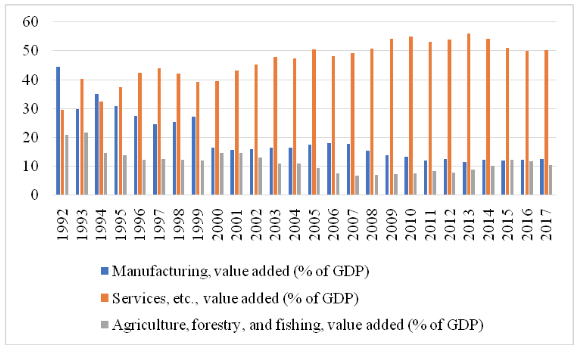
Source: compiled by the authors
Since 1999, the manufacturing sector in Ukraine has significantly lost its potential as an industrial driver of the country; in 2016, the value added of the sector was 14.19% of GDP, while in 1992 the value added was at the level of 43.5% of GDP. Additionally, based on the data of World Bank national accounts data, we have analyzed the share of industry value added in the GDP structure depending on the country's income level: high, low, above and below average income for 2017 (Fig. 4). The calculation of the average industry value added in the GDP structure in the group of high-income countries is 14.1 %, low-income countries – 7.6 %, above average income – 12.6 %, below average income – 14.5 %. It can be concluded that the share of industry value added in the GDP structure in Ukraine is similar to the GDP structure of high-income countries.
Fig. 4
Industry value added in the structure of GDP
depending on the income level of countries, 2016
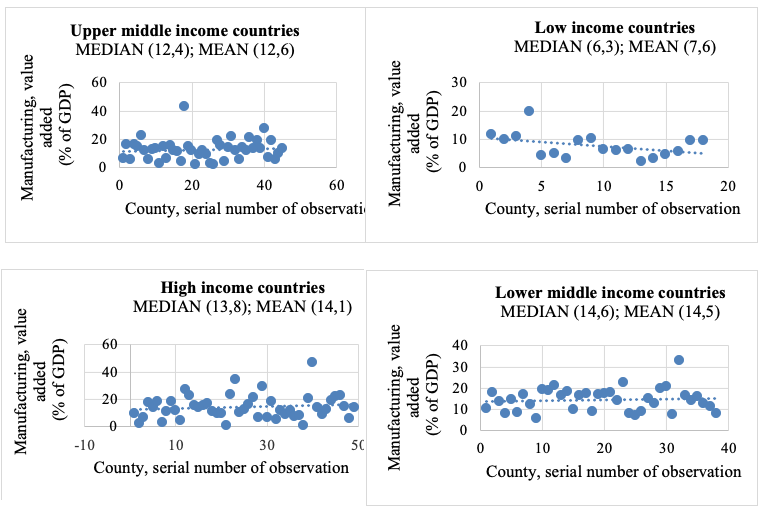
Source: compiled by the authors
Using Eurostat statistical data on the structure of value added by factor for the production sector of the European Union (Section C, integrated system of classifications of economic activities and products NACE Rev. 2), it has been determined that, in 2016, the largest sectors in terms of value added and employment are: manufacture of motor vehicles, trailers, semi-trailers; manufacture of machinery and equipment; manufacture of food products and manufacture of fabricated metal products (see Fig. 5).
Fig. 5
Value added at factor cost, European
Union (28 countries), million euro, 2016
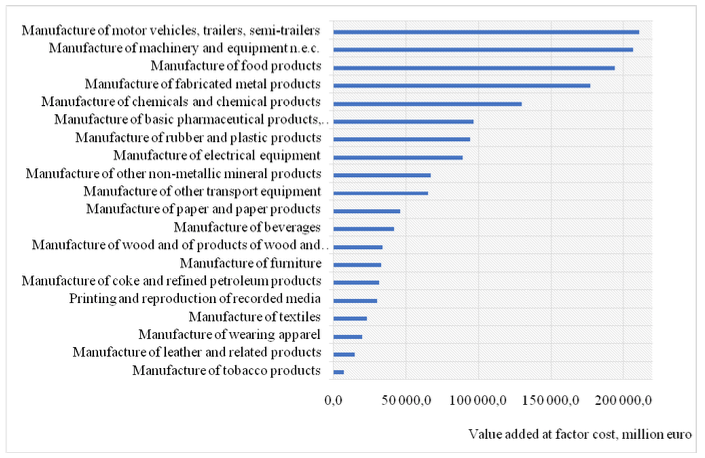
Source: compiled by the authors
In General, at the NACE division level, the manufacturing sector consists of 33 different sectors. Given the structure of exports and imports of goods in the manufacturing sector, the specialization of the member States of the European Union is well pronounced.
We have analyzed the impact of the macroeconomic environment on the innovative activity of enterprises. We have used the indicator of total expenditure on innovation activities (total sum of expenses) to assess the innovative activity of enterprises. The data was taken from the official website of State statistics services of Ukraine, section – Economic statistics /Science, technology and innovation). Six broad dimensions of governance from the Worldwide Governance Indicators (WGI) were adopted for the evaluation of factors of the external environment of enterprises: voice and accountability (reflect perceptions of the extent to which the Ukrainians are able to participate in selecting their government, as well as freedom of expression, freedom of association, and free media); political stability and absence of violence/terrorism (reflects perceptions of the likelihood of political instability and/or politically-motivated violence); government effectiveness (reflects perceptions of the quality of public services, the quality of the civil service, the quality of policy formulation and implementation, etc.); regulatory quality (reflects perceptions of the ability of the government to formulate and implement sound policies and regulations that permit and promote private sector development); rule of law (reflects perceptions of the extent to which agents have confidence in and abide by the rules of society, etc.); control of corruption (reflects perceptions of the extent to which public power is exercised for private gain, including all forms of corruption, "capture" of the state by elites and private interests.)
The six aggregate indicators are based on over 30 underlying data sources reporting the perceptions of governance of a large number of survey respondents, enterprise, citizen, expert assessments worldwide (Kaufmann et al, 2010).
Fig. 6
Assessment of the impact of the macroeconomic environment on the
total expenditure on innovation activities (total sum of expenses)
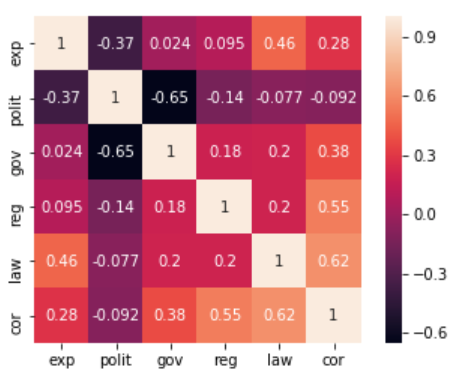
Notes: exp – total expenditure on innovation activities (total sum of expenses);
tech – new technological processes put into service, process;
polit – political stability and absence of violence/terrorism,
gov – government effectiveness;
reg – regulatory quality;
law – rule of law; cor – control of corruption.
Source: compiled by the authors
The analysis of the pair correlation allows drawing a conclusion about a direct dependence between total expenditure on innovation activities (total sum of expenses) and indicators from WGI - Rule of law and Control of corruption. Multivariate distributions of the considered indicators and their (symmetrical) variation-covariance matrices are presented in Figure 7.
Fig. 7
Scatterplot Matrix
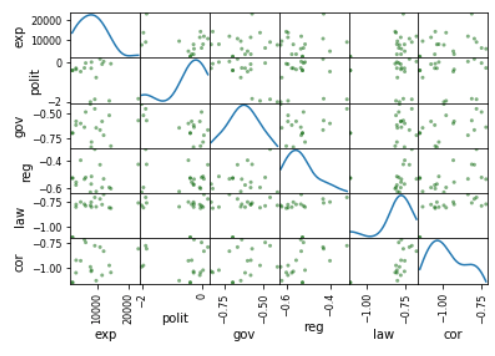
Notes: exp – total expenditure on innovation activities (total sum of expenses);
tech – new technological processes put into service, process;
polit – political stability and absence of violence/terrorism,
gov – government effectiveness;
reg – regulatory quality;
law – rule of law; cor – control of corruption.
Source: compiled by the authors
In the scatter-matrices, the diagonal elements give the variances of the variates, and the off-diagonal elements give the covariance of pairs of the variates.
The definition of the structure-forming and priority sectoral vector is a relevant issue for the development of the manufacturing sector in Ukraine. The strategy of the state policy on the support of individual sectors should correlate with the strategy of socio-economic development of the country and take into account the current load on the labour market and the overall social importance for individual regions of Ukraine. Yakubovsky (2013) proposed a methodology based on the following criteria to assess the choice of industries for further structural transformation of the industrial complex of Ukraine:
1) Efficiency (what volume of GDP does the industry generate per hryvnia of sold products);
2) Production activity (how fast the industry is developing);
3) Market position (export orientation of the industry and import dependence of the needs of the domestic market);
4) Technological level (how much the development of the industry will contribute to the technological modernization of the industry in accordance with the trends of world technological development). The author has determined that the highest level of innovation, import dependence and intensity of development is present in wood processing enterprises, production of machinery and equipment, pharmaceutical production, production of other non-metallic mineral products, production of railway rolling stock and the main chemical industry.
Vakhovych, Denysyuk (2011) considers the topical issues of the investment support for the innovative development of the Ukrainian regions. The essence of such support is outlined; regularities and regional peculiarities of the investment activity for maintenance of the regions' innovative development are studied. Conceptual approaches to investment support in maintenance of a region's innovative development are offered.
In our opinion, a selective approach to the definition of priority sub-sectors of the manufacturing sector should not only take the economic and legal framework into account, but should also be based on the modern world principles of development (the concept of economic and social development "Industry 4.0", a socially inclusive approach to generating economic growth and the introduction of ideas of a circular economy) in order to increase the competitiveness of Ukrainian producers and reduce their vulnerability due to fluctuations in the markets (Fig. 8).
Fig. 8
Innovative development of industrial complex enterprises
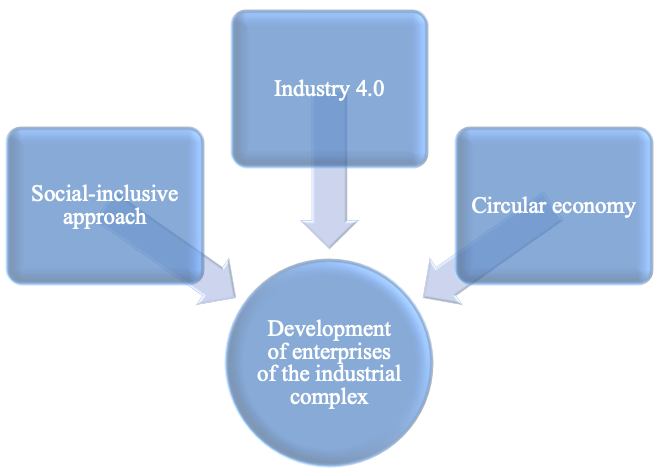
It is only possible to ensure sustainable development and implement the transition to the Fourth industrial revolution in Ukraine, by activating innovation activities and forming a single innovative environment with the development of scientific and production infrastructure and the technological base of enterprises of the manufacturing sector on the basis of the stakeholders approach (Kuzmin, O. Y., Oleksiv, I. B. (2013). The strengthening of cooperation between universities, research centers and industry will stimulate the improvement of the competence level of employees and the improvement of the training system. The development and realization of the growth potential of the Ukrainian manufacturing sector is possible through the introduction of inclusive innovations and an inclusive business model (UNDP, 2008) (doing business, which includes buyers, employees, producers and entrepreneurs at all stages of the value chain, ensuring a mutually beneficial development for all its participants), as well as the application of the principles of a circular economy. In the modern world, circular economy is applied in many areas of industrial complexes: the automobile industry, manufacturing of chemical and medical equipment, pharmaceutics, etc. (UPS/GreenBiz Research Study, 2016). Considerable attention should be paid to the financing of innovative activities (Zakharkina et al., 2018).
Table 1
Directions of implementation in the industrial complex of Ukraine
The concept of economic and social development "Industry 4.0" |
Socially inclusive approach |
Principles of circular economy |
restructuring and simplification of business processes; building value chains using cyber physical systems, digital data, the Internet of things, the Internet of services, and building Smart businesses; automation of ordering, control of delivery and setup of the ability to track the finished product from the warehouse in the enterprise to the end customer; introduction of personalized mass production release; generation of a flow of new knowledge and expanding technology transfer; introduction of the production of high-tech samples of mechanical engineering products. |
creation of inclusive models of business development and creation of new jobs for the fair distribution of goods, services and dividends in the society in monetary and non-monetary forms from the growing welfare; support of inclusive and sustainable business practices; creation of inclusive innovative business start-up models for different segments of the population (including youth, internally displaced persons, veterans and ATO participants, people with disabilities); adaptation of goods and services in depressed regions of the country with the use of information and communication technologies; implementation of the principle of the difference between growth and development in the management of industrial enterprises; attracting investment to overcome barriers to inclusive development. |
creation of closed supply chains to maximize value added throughout the product life cycle (maintenance, re-use of products, recycling-recovery, processing); optimization of consumption processes through the development and distribution of products, components and materials that correspond to a high level of reuse; strengthening control over natural resources and maintaining a sustainable balance of renewable resources; identification and prevention of negative external effects of current production activities. |
Technology and innovation is a key enabler for the future of production, as the adoption and diffusion of emerging technologies is the crux of the Fourth Industrial Revolution. In order to do this, countries need an advanced, connected and secure technology platform. They need to continually upgrade the technology infrastructure to ensure that their platform is advanced enough to fully operate emerging technologies (Readiness for the Future of Production Report, 2018).
The tremendous role traditionally played by governments in fostering private-sector innovation is now expanding, and savvy companies are taking full advantage of a wide range of governmental support, both traditional and new. In Japan, the Ministry of International Trade and Industry (MITI) sets the industrial policy and supports Japanese industrial competitiveness through large-scale funding of selected high-priority advanced technologies. Similarly, the European Community and its member states support numerous cooperative research ventures (Ashok, Ronald, 1993).
While the Airbus is perhaps the best-known of these, many others have been conducted under the umbrella of ESPRIT, EUREKA, and other collective public/private efforts. The European Community is also now beginning to use EC-wide standards both to stimulate innovation and to reduce risk (Ashok, Ronald, 1993).
In the United States, despite strong resistance over the past decade to “industrial“ or “technology“ policy, there are also widespread efforts at all levels of government to foster innovation. The National Aeronautics and Space Administration (NASA) has long supported innovation and commercialization of technology. Other federal labs, particularly those of the Department of Defense and the Department of Energy, are now moving aggressively to make their resources available for cooperative research with individual businesses or industries.
There is much support for innovation at the state and local levels in the United States and at the provincial level in Canada. Local as well as federal governments and private industry are supporting large numbers of manufacturing technology centers and technology extension services designed to foster innovation in small and medium-sized businesses (Ashok, Ronald, 1993).
The work (Wakim, 2017) defines the general principles on the basis of which highly developed states introduce administrative and economic mechanisms to stimulate innovation, including: a detailed conceptual framework that is dynamic, flexible and adequate to the changes taking place in the economy, and differentiation of the types of innovative activity depending on the sector of economy in which it is integrated; a state innovation policy and the legal mechanism of its maintenance that are enshrined in law; the grounds for the application of the measures of state support for innovation are formal and do not depend on the will of the state, however, certain reservations must be provided.
Let us consider various tools for stimulating innovation activity. First, it is necessary to provide state guarantees, such as targeted public investment, insurance of risks of innovative enterprises, social insurance of employees involved in innovation activities. It is advisable to apply special tax, customs and depreciation benefits to innovative enterprises, as well state support measures applied in the field of innovation that can be divided into economic and organizational measures.
Thus, the measures of economic support include state lending, subsidies, leasing of equipment necessary for innovation, and the like. Organizational measures include state planning, creation of special programs for the development of innovative enterprises, running topical fairs and other events, and encouraging young professionals. In addition, foreign countries pay special attention to measures that stimulate cooperation of industrial corporations in the field of research, as well as cooperation of universities and research institutes with the industrial sector.
It should be noted that tax regulation is one of the most effective methods of state influence on the development of innovations. Different countries use various tax preferences or their combinations to stimulate innovation activity, namely:
– Provision of research and investment tax credit, i.e. deferral of tax payments in terms of costs from profit for innovative purposes;
– Reduction of the tax on the growth of innovation costs;
– Years-long "tax holidays" on the profit received from the implementation of innovative projects;
– Preferential taxation of dividends of legal entities and individuals received on the share of corporate rights in innovative enterprises;
– Reduction of profit tax rates for custom and joint R&D;
– Preferential taxation of profits derived from the use of innovation;
– Reduction of taxable profit in the amount of the cost of devices and equipment transferred to HEIs, research institutes and other innovative organizations;
– Transfer of a part of the profits of an innovative organization to special accounts with subsequent preferential taxation in the case of the use for innovative purposes (Alekseev, 2012).
Tax incentives for capital investments are usually provided in the form of investment tax credit to companies investing in the introduction of new machinery, equipment and technologies. The peculiarity of such a tax allowance lies in the fact that it is deducted from the amount of the charged corporate tax, in contrast to the usual allowances that are deducted from the sum of taxes. Most countries use a tax credit with a profit tax because it performs the most stimulating function, however, the reimbursement occurs only after the introduction of innovations into operation (Wakim, 2017).
According to the results of the analysis of industry value added share in the structure of GDP, depending on the level of the country's income, it can be concluded that in Ukraine, the share of industry value added in the structure of GDP is similar to the GDP structure of high-income countries. Wood processing enterprises, manufacturing of machinery and equipment, pharmaceutical production, production of other non-metallic mineral products, production of railway rolling stock and the main chemical industry have the highest level of innovation, import dependence and development intensity.
During the research, the authors have determined that the innovative development of enterprises should be based on the concept of Economics and Society Development “Industry 4.0”, on the social inclusive approach and the principles of circular economy. This will contribute to economic national security of Ukraine and the competitiveness of domestic enterprises in the world market.
In order to stimulate innovation, advanced economies use a combination of different incentives aimed at both the most innovative enterprises and other actors of the national innovation system, whose activities are accompanied by an innovation cycle. The most common means of encouragement is the application of a special tax regime for innovative enterprises, which allows investing more into the development of innovations. Creating special units of innovative activity based on educational establishments, the association of innovative enterprises in the sectoral direction for co-operation allows creating a powerful and branched innovation system. To achieve good results, businesses also need to be proactive overall in their dealings with the government in areas of innovation and commercialization. This serves as a good starting point to ensure innovative development of industries and economic growth in Ukraine.
This work was supported by the Ministry of Education and Science of Ukraine (Project No. 0117U003922 «Innovative drivers of national economic security: structural modeling and forecasting»)
Alekseyev I.V., Zheliznyak R.Y. (2012) European experience tax stimulation of innovation activity. Journal of Lviv Polytechnic National University «Economic and management issues», 725, pp. 7-16. (in Ukrainian)
Ashok, B., Ronald, S. (1993). The Role of Government in Fostering Innovation [online]. Retrieved from: http://www.adlittle.com/sites/default/files/prism/1993_q1_23-27.pdf
European Commission – Press release, European Innovation Scoreboard 2018: Europe must deepen its innovation edge [online]. Retrieved from: http://europa.eu/rapid/press-release_IP-18-4223_en.htm
European Commission, EUROPE 2020 – A strategy for smart, sustainable and inclusive growth. Brussels. [online]. Retrieved from: http://ec.europa.eu/eu2020/pdf/COMPLET%20EN%20BARROSO%20%20%20007%20-%20Europe%202020%20-%20EN%20version.pdf
Guisan, M. (2008) Manufacturing and Economic Development: Inter-sectoral relationships in Europe, America, Africa and Asia-Pacific, 1999 – 2006. Regional and Sectoral Economic Studies, 8 – 2, pp. 73 – 88.
Helper, S., Krueger, T., Wial., H. (2012) Why Does Manufacturing Matter? A Policy Framework. Brookings, February Issue, pp.1 – 52.
Kaldor, N. (1967) Strategic Factors in Economic Development. Ithaca: New York State School of Industrial and Labor Relations, Cornell University.
Kaufmann, D., Kraa, A., Mastruzzi M. (2010) The Worldwide Governance Indicators : A Summary of Methodology, Data and Analytical Issues. World Bank Policy Research Working Paper, p. 30.
Kindzers’kyi, Yu. V. (2017) Deindustrialization and its determinants in the world and in Ukraine, Ukraine Economy, 11, pp. 48 – 72. (in Ukrainian)
Kucera, D., Milberg, W. (2003) Deindustrialization and changes in manufacturing trade: Factor content calculations for 1978–1995, Review of World Economics, 139(4), pp. 601–624.
Kuzmin, O. Y., Oleksiv, I. B. (2013). Forecasting enterprise performance indicators basing on stakeholders' interest’s congruence. Actual Problems of Economics, 147(9), pp. 219-228.
Kuznets, S. (1966) Modern Economic Growth. New Haven: Yale University press.
Kuznets, S. (1971) Economic Growth of Nations. London: Oxford University Press.
On the decision of the National Security and Defense Council of Ukraine dated May 6, 2015 "On the Strategy of National Security of Ukraine": Decree of the President of Ukraine dated May 26, 2015 № 287/2015 [online]. Retrieved from: http://zakon5.rada.gov.ua/laws/show/287/2015 (in Ukrainian)
Rafaelita, M. (2014) The Philippine Manufacturing Industry Roadmap: Agenda for New Industrial Policy, High Productivity Jobs, and Inclusive Growth. Philippine Institute for Development Studies Discussion Paper Series, 32, pp. 1 – 80.
Readiness for the Future of Production Report 2018, World Economic Forum’s System Initiative on Shaping the Future of Production [online]. Retrieved from: http://www3.weforum.org/docs/FOP_Readiness_Report_2018.pdf
Rowthorn, R. E., Ramaswamy, R., 1997. Deindustrialization: Causes and Implication, IMF Working Paper, 97/42, pp. 1-38 [online]. Retrieved from: https://ssrn.com/abstract=882291
State statistics service of Ukraine, 2019 [online]. Retrieved from: www.ukrstat.gov.ua
Szirmai, A., Verspagen, B. (2015) Manufacturing and Economic Growth in Developing Countries, 1950 – 2005. Structural Change and Economic Dynamics, 34 (C), pp. 46 – 59.
The Growth of the Circular Economy: A 2016 UPS/GreenBiz Research Study [online]. Retrieved from: https://sustainability.ups.com/media/UPS_GreenBiz_Whitepaper.pdf/
The National Science and Technology Council, Subcommittee for Advanced Manufacturing , Penny Hill Press (2016) ADVANCED MANUFACTURING: A Snapshot of Priority Technology Areas Across the Federal Government. Washington, D.C., [online]. Retrieved from: https://www.whitehouse.gov/sites/whitehouse.gov/files/images/Blog/NSTC%20SAM%20technology%20areas%20snapshot.pdf
The World Bank Group. Worldwide Governance Indicators (WGI), [online]. Retrieved from: http://info.worldbank.org/governance/wgi/index.aspx#reports
Tregenna, F. (2009) Characterising Deindustrialisation: An Analysis of Changes in Manufacturing Employment and Output Internationally. Cambridge Journal of Economics, 33 (3), pp. 433 – 466.
United Nations Development Programme (2008) Creating Value for All: Strategies for Doing Business with the Poor. New York: UNDP.
Vakhovych, I. M., Denysyuk, G. L. (2011). Conceptual grounds for investment support of region's innovative development. Actual Problems of Economics, 115(1), pp. 138-144.
Wakim, V.E. (2017) Stimulation of innovation activity: a comparative legal aspect. Economic theory and law. Commercial law, 2(29), pp. 134 – 145. (in Ukrainian)
Yakubovsky, M.M. (2013) Structural vector of activation of industrial development. Ukraine Economy, 12, pp. 22 – 39. (in Ukrainian)
Zakharkina, L.S. (2009). Balancing of innovative development of machinebuilding enterprises in strategic planning process. Actual Problems of Economics, (3), pp. 88-95.
Zakharkina, L., Myroshnychenko, I., Smolennikov, D., & Pokhylko, S. (2018). Efficiency of innovation activity funding as the driver of the state’s national economic security.Montenegrin Journal of Economics, 14(4), pp. 159-173. doi:10.14254/1800-5845/2018.14-4.11
1. Department of Finance and Entrepreneurship; Sumy State University; Sumy, Ukraine. Doctor of Economics. Professor o.zoaharkin@finance.sumdu.edu.ua https://orcid.org/0000-0001-9317-252X
2. Department of Finance and Entrepreneurship; Sumy State University; Sumy, Ukraine. Doctor of Economics. Professor i.basantsov@finance.sumdu.edu.ua
3. Department of Management; Sumy State University; Sumy, Ukraine. PhD in Economics. Associate Professor, myroshnychenko@management.sumdu.edu.ua
4. Department of International Economic Relations; Sumy State University; Sumy, Ukraine. PhD in Economics. Senior Lecturer. v.shcherbachenko@macro.sumdu.edu.ua